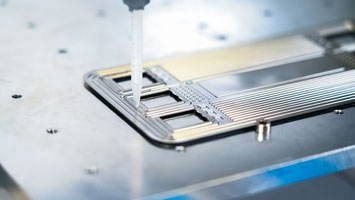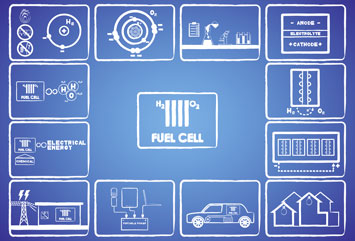Dispensing Technology for Fuel Cell Production
Automated application of adhesives and sealing pastes – a technology for a wide range of dispensing applications
ViscoTec takes care of many different applications in the production process of a fuel cell, such as bonding and sealing. Extensive dispensing tests were carried out to obtain particularly high-performance connections. The result: Reliable connections for particularly long-lasting cells and easy assembly, coupled with simple production technology.
Fuel cell technology has the potential to replace batteries, generators, and emergency power units in numerous applications. Yet the name is slightly misleading. The electric plants are quiet, environmentally friendly, and at the same time highly effective. And they have little to do with anything that one might otherwise associate with the word “fuel” in relation to energy generation. Such as heating oil, coal or other fossil fuels.
Not all fuel cells are the same
Contemporary fuel cells work with natural gas, hydrogen and methanol and do not emit any toxic gases. They can be used as stationary energy converters to provide primary energy in heating systems. For larger buildings such as supermarkets, high-rise buildings, but also entire city districts and regions, as well as large industrial plants. In moving applications, such as an energy source for trains, buses, trams, airplanes, submarines, electric cars or even laptops and even smaller electronic devices. Mobile fuel cells have to be much more stable than stationary ones. In vehicles, for example, they have to withstand many adversities. Potholes, seasonal temperature fluctuations and the most diverse driving styles of the operators. They also have many more start-stop cycles than stationary fuel cells, which are operated continuously.
In order to be able to manufacture fuel cells economically in production, the assembly technology must be adapted accordingly: For significantly shorter cycle times. In the area of dispensing technology, adhesive bonding processes, which have already established themselves in many other areas, can help. For example, with the right materials, joining and sealing processes can be combined.
Dispensing of an adhesive and sealing bead on interconnectors
The goal in another application is to dispense a uniformly thick dispensing bead onto interconnectors. The bead geometry in the liquid state is approx. 2.95 mm wide and 1.16 mm high. A one-component glass solder paste is dispensed. The filler-loaded paste contains glass particles and is therefore highly abrasive. A real challenge for the dispensing pumps used in the ViscoTec RD Dispenser series. But due to low-shear dispensing and carefully selected components, dispensing of this material is permanently possible. The viscosity of the paste is between 285,000 and 914,000 mPas, with a density between 3.3 and 3.8 g/cm³. The sealing bead is applied in a wide variety of geometries, i.e. as a rectangle or ring, depending on the component section.
The top priority in this dispensing process is uninterrupted application and absolute repeat accuracy. As this material seals the fuel cell and represents a safety function. The sealing bead also serves as an assembly aid until the fuel cell is operated for the first time. This is because it then becomes so hot that the binder of the glass solder paste evaporates, and the components are firmly connected to one another.
Depending on the material properties, a processing unit for material treatment (agitating, circulating and/or application of vacuum) can be integrated. This serves the purpose of process stability and quality assurance. A specially adapted agitator on the drive shaft prevents possible sedimentation of the fillers.
Continuous application onto an endless membrane
However, ViscoTec does not limit itself to adhesive and sealing applications in fuel cell production. For example, it also deals with the production stage of the actual core component of many fuel cells: The membrane-electrode assembly, which contains the proton exchange membrane (PEM) and the active catalysts. Here, the corresponding catalyst-loaded pastes of the anode and cathode are applied to the semi-permeable membrane in a continuous process via the dispenser. Material compatibility of the dosing components with the catalyst pastes is essential, otherwise the activity of the catalysts could be negatively affected.
The low to medium viscosity catalyst pastes, developed by the customer especially for this application, are applied evenly in a constant width using flat nozzles. Here, too, perfectly constant dispensing is essential. As pressure fluctuations would have a negative effect on the layer thicknesses of the active surfaces of the MEA and therefore on the quality of the end product – the fuel cell. Dispensing with ViscoTec dispensing technology is absolutely constant. There are no pressure fluctuations, and the dispensing is easily adjustable – depending on the path speed of the robot when applied to the membrane. At the end of a process, the easy and fast cleanability as well as the high process reliability of the dispensing technology is impressive.
One technology for a wide range of applications in fuel cell production
ViscoTec offers complete dispensing solutions for a wide variety of applications and in association with a wide variety of materials. The portfolio ranges from the emptying of materials to treatment and high-precision dispensing. There is no negative impact on the properties of the dispensing material. Due to the application-specific selection of suitable materials for the dispensing system and the low-shear dispensing in the low pressure range.
There is a special solution for materials where contact with metals would lead to critical and undesirable reactions and incompatibilities. The RD-EC MF dispenser was added to the portfolio some time ago. To avoid chemical reactions such as curing or crystallization during the dispensing process, any contact with metal in the material contact area of this dispenser was avoided.
In addition, all dispensers of the RD series can be optionally equipped with a ceramic rotor. To achieve the longest possible service life and the highest process stability for the dispensing of highly abrasive fluids.
Please feel free to use our contact form for your inquiry. We are looking forward to your message.


